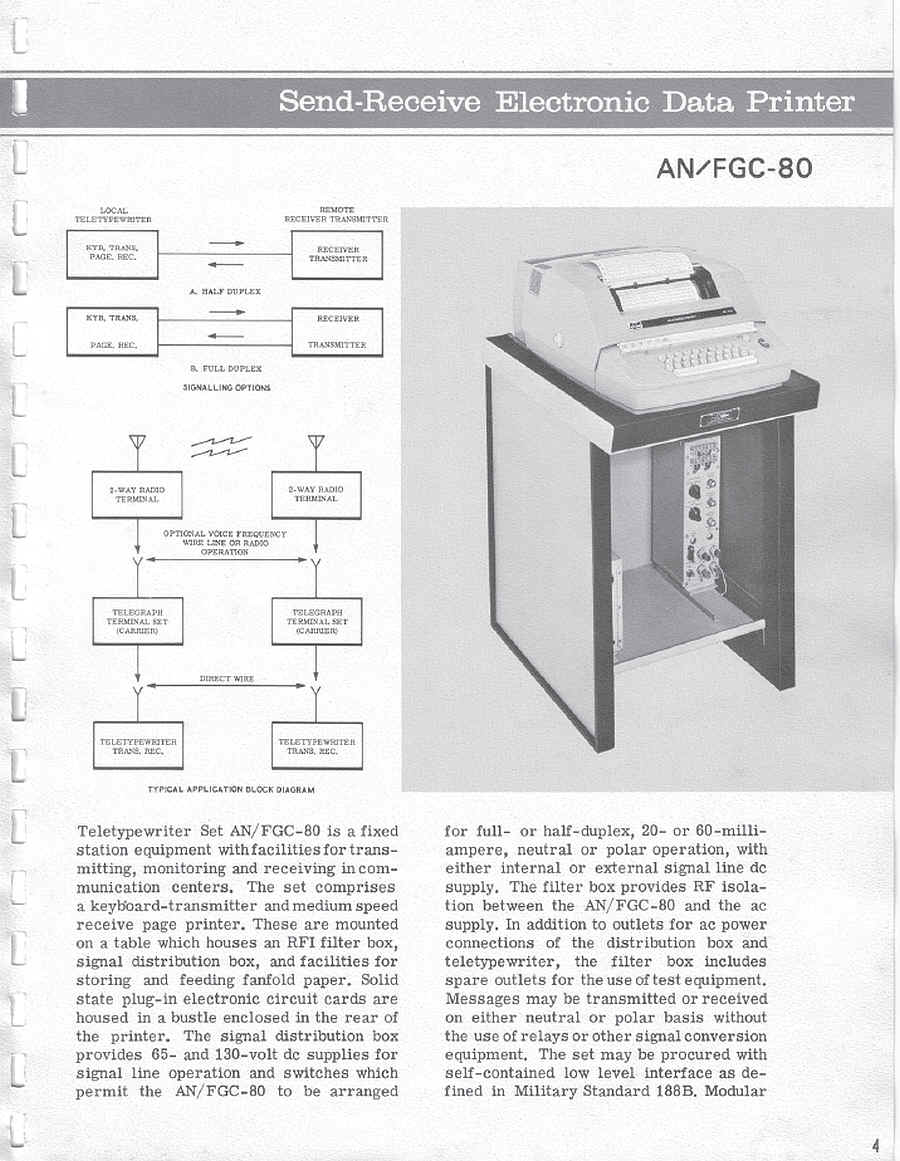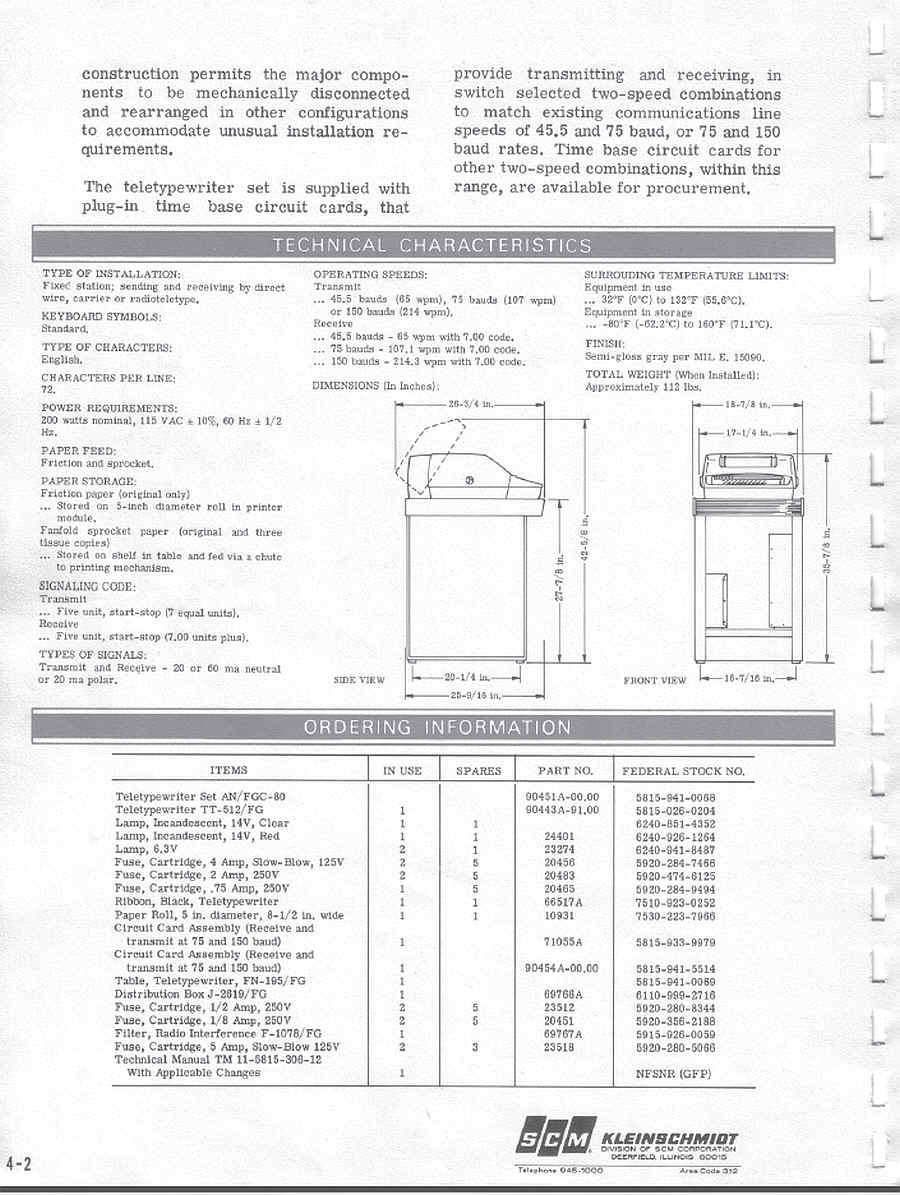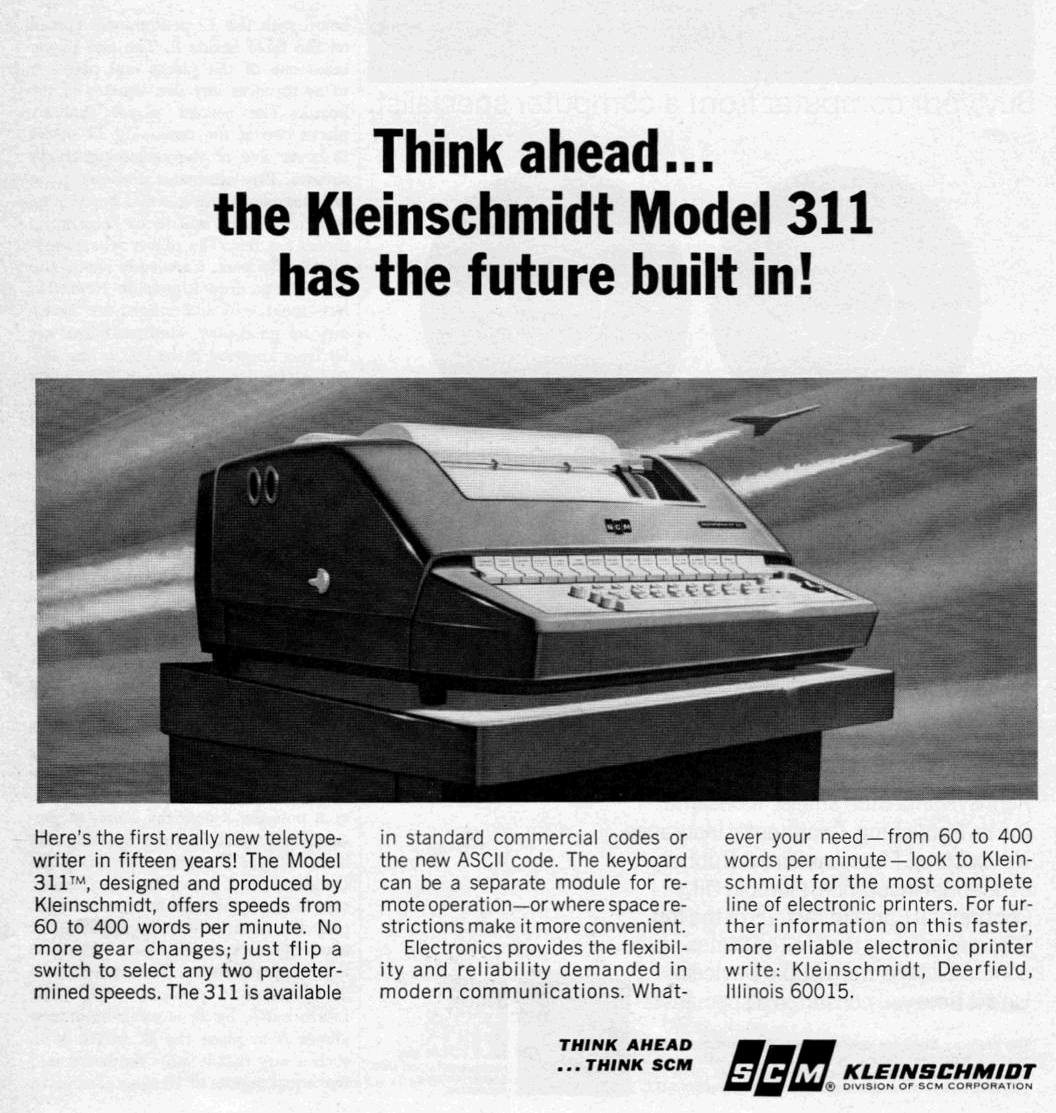|
Some background on the use of the Kleinschmidt AN/FGC-80 high speed or
"data line
printer". I was in the Army. The Army was a big user of
Kleinschmidt machines. The
AN/FGC-80 was a "limited production" machine which came out in
the early 70s
(I think) as a small, high speed printer for use in data communications.
Recall that
in those days, "high speed" data printers of the day were
usually monstrous, room filling
things, so the AN/FGC-80 was Kleinschmidts' answer to something smaller
and
just as fast. The AN/FGC-80 was a good machine, reliable, but was also
lost in the
developments of the era when everyone was building higher speed
communications
equipment and printers.
The users: Primarily AUTODIN Switching Centers (ASCs), usually in the
R&A
Sections (Reports and Analysis). Most such printers in an ASC were set
up
for ASCII. I never saw one set up for Baudot, although they were
advertised as being
Baudot capable. By that time, Baudot was on its' way out, and ASCII was
the
"new" protocol in most comms applications (except for Model V
AUTODIN and
tactical field CommCenters which still used older teletype equipments).
The AN/FGC-80 was a fixed-station piece of equipment. It was not used in
the field or tactical operations. Probably too new, and too expensive
for field use,
and not ideally suited for that kind of work. (Field units in the Army
were still
largely using 1950s era Kleinschmidts such as TT-4s, TT-98s, TT-76s
and AN/FGC-25Xs).
The other users of the AN/FGC-80s were DPUs in the Army, or Data
Processing
Units which were non-communications facilties and operations. DPUs
handled
requisitions, supply, logistics, etc (and sent their online traffic
requirements via
CARD ("Data") traffic to the servicing CommCenter for
transmission (and reception).
Most CommCenters had a Card (Data) send and receive capability as well
as
teletype (called "narrative"), and other media.
Within AUTODIN, AN/FGC-80s replaced some of the Model 32/33s
and some of the Model 28
ASRs that were then in use, but not necessarily all of them (for
instance, within
most AUTODIN ASCs, we were still using multiple sets of Model 28 ASRs in
the
SERVICE Section before those were replaced by the AN/FYA-71 (DSTE)
terminals.
(The "Service" Section was that part of a CommCenter or ASC
that handled mutilated,
garbled or lost messages and other message "servicing"
actions. Depending on traffic
volume, this was usually a full time job for the service clerk(s)
working in the Service
Section).
In the case of the DPUs, the AN/FGC-80s replaced older, leased UNIVAC
1004
and 1005 machines, themselves huge beasts, along with several variations
of IBM
equipment. DPUs generally did not, or never used teletype equipment,
since this
type of equipment was not compatible with Data Processing requirements.
I worked in CommCenters in the Army. Tape Relays, and Tributaries in the
General
Service Common User networks did not use the AN/FGC-80s, and neither did
the DSSCS (Y side) CommCenters (SPINTCOMM/CRITCOMM). The distribution
of AN/FGC-80s was very, very limited and tightly controlled.
The Navy ASC at Albany, GA (RUCL) had a few AN/FGC-80s (2 of them in the
R&A Section). These were generally used for printouts of reports
rather than
online operational communications traffic. I know because I was TDY
(TAD)
to ASC Albany a few times from my post in Florida. (In the 70s, ASC
Albany
was always short-staffed, and often requested TDY/TAD augmentation from
its'
outlying connected trib stations. TDY personnel were mostly Army and Air
Force for 6 to 8 weeks at a time).
The AN/FGC-80 in ASCII mode was capable of printing an 80-column page.
("80 column" equates to about 80 characters per line).
In Baudot mode, it could only print about 69 characters per line, so
as to allow
it (in Baudot mode) to interoperate with other teletype equipment that
had the
same technical operating characteristics (and limitations).
Hope this helps,
Dave
DE RUMLNHA
Dave explains the AN/UGC-74
The AN/UGC-74 was part of a still-born family of Kleinschmidt teletype
equipment
designed for the Army in the mid-60s. It was called the "Forward
Area TeleType or FATT.
The Army never ordered the FATT which was originally designed during the
Viet War
to replace the old style, slower, electro-mechanical machines in use at
the time. The
Viet War was fought using 1950s vintage teletype gear......especially at
the tactical
level.
In the early 80s, the Army relooked the FATT and decided they didn't
need or want
it, because too much newer equipment was already being fielded,
especially the
Model 40s and some other systems. The Army however did order the
AN/UGC-74
which was the printer part of the FATT system.
While the FATT (and UGC-74) was originally a KLI design, by the time the
Army ordered the UGC-74 printer, KLI had largely gotten out of the
teletype biz and
so the design was sent over to another company (at the moment, the name
of
the "other" company escapes me; in any event, they made all of
the UGC-74A
models which we used in the mid and late 80s).
The UGC-74 in the Army was used to replace earlier model TT-4s, and
T-98s
in tactical units using shelters for teletype traffic, mostly
CommCenters and
RATT. Most of these were set up for Baudot use in tactical
configurations
and they were intended to work with slower TT-76s (which provided tape
capability). In the fixed-station, a few UGC-74s were used and these
were
set up for ASCII, mostly on the Y-side. When used in the fixed station
environment, they were usually connected to a Model 40 at one end of the
circuit and the UGC-74 at the other end with no tape send/receive
capability.
Dave
Jack K0TTY says -
"That Kleinschmidt/SCM machine with the type drum (similar to the
UGC74) was called a 311 (or maybe 321)
commercially. Gordon Eliot White covered it in one of his CQ Magazine
“Surplus Sidelights” columns in the 60’s. It was supposedly a “data
terminal” for high speed communications."
I have not looked at the pic but if its a Kleinschmidt 311 I have
worked on them at WU. Even went to school in Atlanta for them.
WU used one in a WX circuit at McConnell AFB in Wichita, KS. Made
a lot of $ in overtime when they failed in the middle of the night which
they did often. We had a spare to swap out. They were 300
WPM or 300 baud as I recall. Two little hammers hitting a spinning
drum to type. Wear out the hammers in a couple months or so.
I have no parts or desire to work on one. Sorry!
Wayne
KB1FDW
|

Two pages from the 1970 KLI Military catalog about the FGC-80 from
Navy-radio.com
|
|
We do have - TM 11-5815-306-12 |


